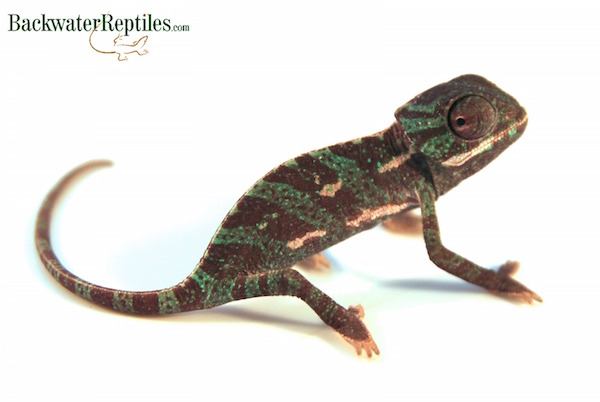There’s no question that caring for baby chameleons is a fragile process that requires planning and careful attention.
Breeding chameleons is part art, part science. First, you have to find a compatible adult breeding pair and wait for them to hit it off, which is an entire article in and of itself.
Next, feed the female well and wait for her to dig a hole and bury her eggs–this typically happens around 30-40 days after copulation (called the “gestation” period). It can be much longer for certain species, but generally, this is a safe timeframe.
Digging is a very secretive process and the female should not be disturbed or bothered while it’s occurring. It usually takes 3-5 hours, but can easily be longer. The reason is, sometimes females will dig a test hole, then abandon it and start over if it’s too damp, not damp enough, etc.

After the eggs have been buried, they need to be very carefully dug up and placed into a container with damp vermiculite or perlite. This is a tedious process because the eggs need to remain in the same orientation in which they were uncovered. Switching them around, flipping them, or turning them could mean the babies won’t be born. Mark the top of each egg with a pencil, so you always know which way is “up.”
And then…you wait. And wait. The incubation period of the eggs depends upon the species, but generally, it takes around six to twelve months. For instance, the Flapneck eggs in this clutch were laid on May 21st, 2014 and began hatching on May 25th, 2015, around one year later. Some species hatch in as little as 90 days, such as the Johnston’s chameleon (Trioceros johnstoni). Parson’s chameleons can take up to two years!
The babies in this post are Flapneck Chameleons (Chamaeleo dilepis) and Veiled Chameleons (Chamaeleo calyptratus). The clutch size for the Veiled was approximately 60 babies, while 44 Flapnecks were born.
Baby Chameleons – After the hatch
After hatching, the babies need to be transferred to proper enclosures. Multiple babies can be housed in the same cage for a period of time (usually around 1-2 months), but be sure that when they reach a few months old, they get moved into their own homes.
It’s a good idea to size-sort the babies after a few weeks. This means, take all the biggest ones, and put them together, and leave the smaller ones together. This is because there can be dominance issues and the small ones can lose-out during feeding time if they’re getting bullied by the larger ones.
Caring for the babies is similar to caring for the adults, but the babies need to have an abundance of water and should be fed very small prey items at least twice a day, such as hydei fruit flies and pinhead crickets. Make sure you dust the crickets frequently with a quality calcium supplement (RepCal or Repashy is what we use) as the baby chameleons have high growth rates.
As previously mentioned, it is of utmost importance that the baby chameleons remain in a high humidity environment. Automatic misting, or at a very minimum hand-misting, should occur several times per day. We recommend using a smaller cage too, making the insects easier for the chameleons to find. Unlike adult chameleons, we raise our babies in glass-sided enclosures to help maintain adequate humidity.

How to care for baby chameleons – conclusion
Backwater Reptiles’ captive-bred baby Veiled Chameleons and baby Flapneck Chameleons are not yet ready to be shipped to new homes. They need month or two to grow and develop before they are prepared to face the great big world and meet their new owners.
However, Backwater Reptiles does have Veiled Chameleons for sale as well as Flapneck Chameleons for sale that have reached a size and age that is appropriate for shipping. These are wonderful creatures that can make absolutely excellent pet chameleons.


